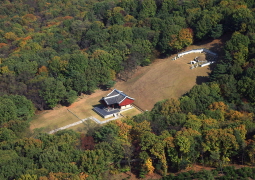
Tomb of Queen Jungsung with last name Seo as a wife of Youngjo, Hongreung
As a tomb for the wife of Youngjo, queen Jungsung (1692 1757), Youngju liked her so much when he was alive that her tomb was located to his along with the stons inscribed with cross.
However, his grandson, Jungso, located his grandfather’s tomb in Wonreung in Donggu-reung, Guri-si, and the right side of the tomb of Seo ended up being left as an empty space forever.
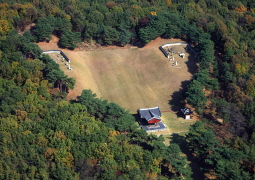
Tomb of the eighth king, Yejong, and the wife of him, Queen, Ansun with last name Han, Changreung
Location of the stonework was structured according to [Jukjooreui] like any other tombs.
However, there was a ring shape underneath of Honryuseok along with lotus leaves on the top of stone roofs such as Palgakjangmyeong. Yejong (1450-1469) was the brother of Dukjong who was served in Gyungreung. His last name was Hwang (晄), and his first name was Myungjo (明照). After he became a crown prince after his brother died, and succeeded as a king in September, 1468. However, he ended up passing away 14 months after he became a king. Queen Ansun (>-1498) became crown princess in 1460 as a daughter of Chungwonbuwongun and promoted with the position 2 years after the queen Jangsoon with last name Han (daughter of Myunghoi Han) died due to illness. It is interesting to see her tomb that was located behind and also relatively higher area of the tomb of queen on the right side compared to other tombs.
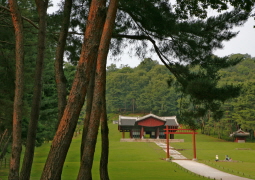
Ikreung, the tomb of the first wife of Sukjong, Queen, Inkyung
As a tomb for the first wife of the 19th king, Sukjong, the queen, Inkhyung (1661-1680), it is located on a relatively higher area in the stair structure with Chamdo starting from Hongsalmun. She died at her age of 20 wihtin 8 days after she had chicken pox. Hwoever, she was a mother of three children, and two of her daughters died before her, and the last daughter ended up passing away at an erly age.
Characteristics of Ikreung were that it was a tomb before the tomb simplification policy (policy for simplifying the tomb when constructing) by the king, Sukjong, and the huge stonework and Palgaljangmyung were in a modified form after Japanese invasion (1592-1598). Jungjagak in Ikreung was a rare place with Iksil in royal tombs in Joseon Dynasty. Iksil indicates an architectural mode with one more room next to each pillar of Jungja.
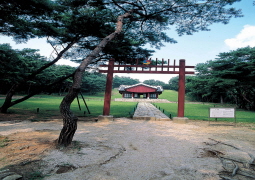
Tomb of Sunhoi crown prince and Gonghoibin with last name Yoon, Sunchangwon
As a tomb for Sunhoi crown prince as the son of the 13th king, Myungjong and Gonghuibin with last name Yoon, Sunhui crown prince (1551-1563) became the crown prince at the age of 7 in 1557 (12th years of reign in Myungjong) but ended up dying at the age of 13.
Gonghuibin with last name Yoon (?-1592) was a daughter of Ok yoon and was promoted to crown princess in 1559. However, as Sunhui crown prince died at his early age, she spent her life for 30 years alone and died. After Gonghuibin with last name Yoon died, people wanted to perform funeral. However, they failed due to Japanese invasion.
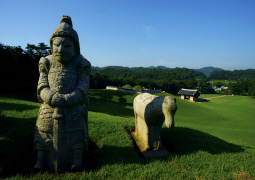
Tomb of Sukjong and the queen, Inhyun, Myungreung
Tomb for the wife of the 19th king, Sukjong, Queen Inhyun, and the second wife, Queen Inwon (Ikreung for tomb of queen Inkyung with the last name Kim) At the age of 14, Sukjong was reigned for the 45 years. During the reign of King Sukjong, the struggle intensified between political parties, people from the south and west, and old doctrines and opinions from private sectors. However, Sukjong performed the Daedeungbub making more accomplishments with Sangpyeongtongbo to support the commercial activities. In 1711, he rebuilt Bukhansan Fortress and made a present appearance as a king who established the administrative palace of Bukhansan Mountain.
Queen Inhyun (1667-1700) with the last name Min was the second wife of Sukjong who succeeded the Queen Ingyung. She lost the position of queen by Hui Bin Chang for having no son-in-law but had it reinstated as those from ordinary citizens had power after Gapsulhwangook. However, she ended up passing away due to deteriorated health conditions in 7 years. There is a story that she died because of the curse from Hui Bin Chang.
Because of this, Hui Bin Chang died. Queen Inwon (1687-1757) was the second wife of Sukjong and a daughter of Jushin Kim, the Gyungeunbuwongun. Tomb of the queen Inwon was originally located on the hill away from Myungreung for about 400 steps. However, Youngjo relocated it to the current position.
In reference, the tomb of Jushin Kim, the father of queen Inwon, and Sindobi are located at Daeja-dong, Deokgyang-gu, Goyang-si.
Myungreung is relevant to the textbook of Joseon royal tombs in the latter period of Joseon Dynasty.
Chamdo, Chungjagak, stoneworks in the unique shape, twin tombs, distribution of Dongwonigang type, and principles of restoration of original shape are well preserved in these cultural assets. Located at the entrance of Seoreung, this place represents royal tombs around this area.
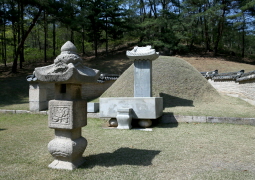
Tomb of Hui Bin Chang as a queen from royal court lady, Daemin tomb
It was originally located at Munhyung-ri, Opo-myeon, Gwangju-gun, Gyeonggi-do, but was relocated to the current area in 1970.
Hui Bin Chang (?-1701) was the only figure that was promoted to the queen from court lady in the history of Joseon Dynasty.
Daebin tomb is located at the corner of Seoreung when coming around from Gyungreung towards Changreung in the small size.
This tomb is in poor conditions than the tombs of noblemen in terms of the location, entire structure of the tomb, and stoneworks.
This shows how Hui Bin Chang is evaluated by historians in the next generations. However, when relocating the tomb, her tomb ended up being located in the current position next to Myungreung.
She is the character that is well-known as Hui Bin Chang, and there are many of the stories handed down to the next generations such as the ones of rocks and pine trees behind the tomb.
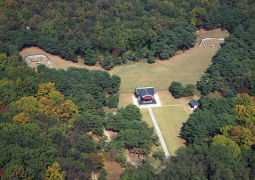
Tomb of Dukjong and Queen Sohe with the last name Han, Gyungreung
This was the twin tomb in Dongwonigang type performed from the reign of Sejo and also the tomb that was built for the first time in Seoreung. In general, the tomb for the king is located on the right, and the one for the queen is located on the left. However, what is unique about this tomb is that the tomb of kign is on the left side, and vice versa for the one for queen. In addition, the tomb for queen is relatively more splendid than the one for the queen. Therefore, people might be confused about this tomb. There is a reason why they were built in that way. Dukjong was the daegun instead of the king as an older brother of Yejong when he died. He actually died when Sejo proceeded tomb simplification policy.
Therefore, Dukjongreong does not have Nanganseok and Mangjuseok. However, the tomb for queen Sohe was built after the husband was promoted as Dukjong. Therefore, her tomb was built in more splendid way than the one for the king.
Dukjong (1438-1457) was the oldest son of the seventh king, Sejo, and the queen Junhee with the last name Yoon. His last name was Chang, and the first name was Wonmyung. As he was in good appearance with courtesy, he was much loved by Sejong and the queen Sohun. However, he ended up dying at the age of 20 as he was weak. The second son of Dukjong, Sungjong, became the ninth king as ‘Dukjong.’
The queen Sohe (1437-1504) was promoted as crown princess on the first year of Sejo giving a birth to Sungjong with Wolsandaegun. As Dukjong died on the third year of Sejo, she gave birth to two sons for three years.
Queen Sohe published the book titled 女訓 containing the principles to follow as a housewife. She lived for another 47 years after Dukjong died. He blamed related parties blaming them that the birth mother of Yunsangun with last name Yoon was dethroned and died. There was a story that Yunsangun hit her with head, and she ended up dying.
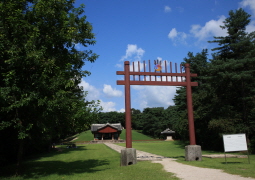
Single tomb of the queen, Jangghyung, with the last name Yoon, Heereung
This is the single tomb of the queen, Janggyung, with the last name Yoon (1491-1515), as the 11th king, Jungjong.
As a daughter of Yupil Yun as a Youngdonbusa, her mother died when she was eight years old, and she was raised by the wife of Wolsandaegun with the last name Park. Afterwards, as the queen Jangsoon with the lat name Han was dethroned due to restoration with the death of Jungjong, she became the queen. Afterwards she gave a birth to Injong in 1515, but she ended up passing away within 7 days due to postnatal illness.
Tomb was originally located at Hunreung (currently Seocho-dong) but relocated to the current area due to the trick of Anro Kim 22 years later (Gwangpil Chung and Gon Nam made a rumor that it was not good for her as there were huge rocks underneath the tomb).
Heereung was the one and only single tomb in Seosamreung. This is also the royal tomb that represents Seosamreung with Yereung. Another characteristic is that the size of stonework is huge as a royal tomb in Joseon Dynasty.
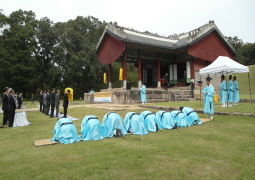
Twin tomb of Injong and the queen, Insuing, Hyoreung
This is the twin tomb of the 12th king, Injong (1515-1545) and the queen Insung with the last name Park (1514-1577).
Injong was so filial that when his mother, queen Janggyung, died, he served the queen Junghyun (the wife of the ninth king, Sungjong). When his father was sick, he tasted medicine before his father and burnt the incense in the sky from the evening to the morning at a place after taking a shower even in winter.
When Jungjong died, he also passed away within eight months. He requested people to bury him next to his parents and not to do anything special or splendid on his tomb. Therefor, there are no memorial stones around his tomb. However, as he was buried near Injong when the queen Insung died, and memorial stones were built around the tomb. Hyoreung is the tomb located in the area that is not open to the public.
As there was no descendant, royal tomb rite is performed by Confucian scholars. Characteristics of it is that there is not much difference on the size and form of the tombs for king and queen.
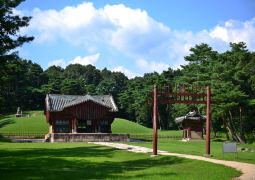
Last tomb following royal tomb policy in Joseon Dynasty, Yereung
This is the twin tomb of the queen of the 25th king, Chuljong (1831-1863), Chulin, Yereung Well-known as ‘prince of Gwanghwa,’ Chuljong became the king next to the 24th king, Hunjong, in 1848 when he died while living in Gwanghwa-do.
This was because he was the one and only descendant of Youngjo.
Grandfather of Chuljong, Eunun-gun, banished as his son, Sanggyegun, to Ganghwa-do as he made scheme against him in 1786.
In 1801, wives of Eunung-gun, Song, and Shin, were killed as they were Christians.
Furthermore, older brother of Chuljong, Wonkyung, was in the middle of making rebellion and caught up that he was killed. Most of the people around Chuljong ended up dying. Chuljong had difficult time and ended up dying on the sixth years (and fourth month) after reigning. Yereung is the gigantic size among Joseon royal tombs as a twin tomb of Chuljong and the queen Chulin. In addition, it is the last tomb that followed the royal tomb policy in Joseon Dynasty.
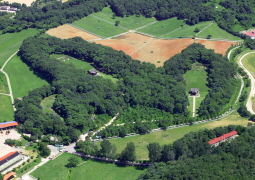
Tomb combined with Jungreung and Hyoreung
Designated as the world culture heritage, Seosamreung is the boastful cultural asset in Goyang.
Designated as the world culture heritage, Seosamreung is the boastful cultural asset in Goyang. In 1865, Yereung was located for Chuljong and the queen Chulin between the Heereung and Yereung that it was called as Seosamreung.
As Heereung was built for the queen Jangghyung, the wife of Jungjong, the history of Seosamreung began.
As Jungreung of Jungjong was built, it was located near Sunreung at Samseong-dong, Seoul.
There are Hyoreung for Injong, the son of Jungjong, and the queen Insung with the last name Park, and the Yereung for Chuljong and the queen Inchul with the last name Kim.
Total area is about 70 thousand pys. It was around 1.3 million pys. However, as time passed by, it was sub-divided
into these areas as they are located today. About half of this place has been designated as a place that is not open to the public.
Other than them, there are three tombs, Sogyungwon, Uigyungwon, and Hyojangwon, and Taesil and 45 tombs including Hui tombs for the queen Yoon.










